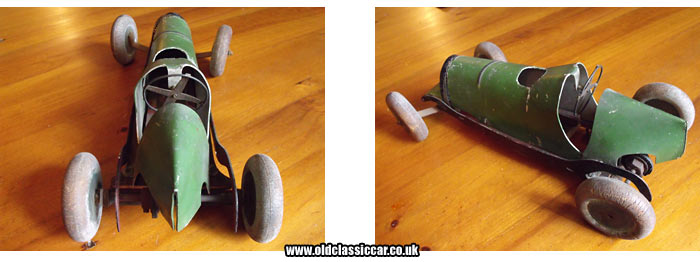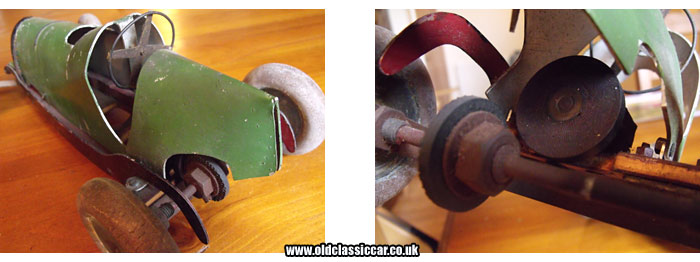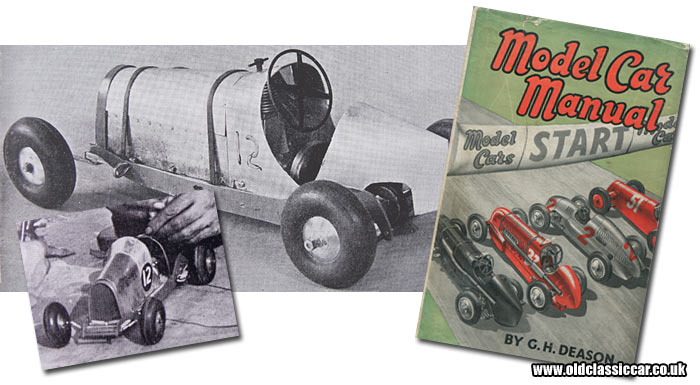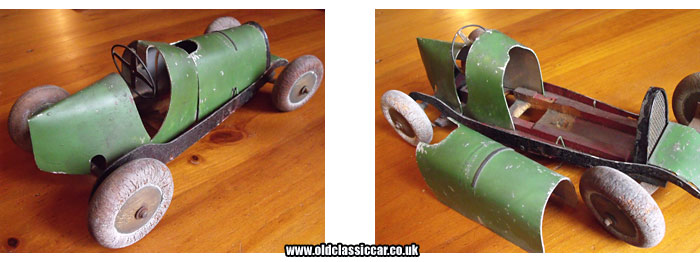Kitten, a Mills-powered diesel model racing car.
Perusing the internet regularly can lead to interesting one-off toys and models turning up. The part-complete single-seat racing car shown below was one such find from a few years ago. At the time I'd assumed it was a one-off creation, put together in a shed or bedroom somewhere to compete in tether-car races. Dating it was proving tricky, as the car it resembled could have hailed from the 1930s through to the 1950s, incorporating in its simple design elements of full-sized Grand Prix racing cars, engine-powered tethered racers from the States (for example the Cox Thimble Drome), and several home-built "specials" of the type regularly seen at British speed hillclimbs, either side of WW2.
|

|
|
It had clearly been fitted with a small model engine at some time, perhaps a type more commonly found in radio-control or control-line aircraft. It measures approximately 12 inches in length, and incorporates a chassis made from aluminium side members, screwed to a wooden base. The aluminium body is in five main sections, namely 1) front apron 2) radiator 3) bonnet 4) scuttle, and 5) tail section. The forward end of the scuttle, and the rear end of the bonnet, have been cutaway somewhat crudely, to accommodate a small petrol or diesel engine. The wheels are wooden, fitted with sponge rubber tyres. While the transmission and engine are long-gone, the rear drive assembly is still present. The rear axle is mounted on tiny hinges attached to the rear of the floor. The axle shaft has a friction disc mounted off-centre, which - when the model is on its wheels - bears upon a second rotating drive plate that would have connected to the engine via a propshaft. Lifting the car off the track allowed the rear axle to drop, thus disconnecting the drive.
|

|

|
|
In America, tethered model racing cars were all the rage with car-mad youths. In this country, building cars such as that shown above was also a very popular pastime, at a time when slot-car racing was yet to have a following. Numerous magazines on the subject were printed, including titles such as Model Cars and of course Meccano Magazine, written to encourage the young (and not-so-young) readership to dig out their saws, drills, glues and paintbrushes, and build something from scratch.
|
"Model Car Manual", published 1949.
In addition to magazines designed to tickle the model-builder's imagination, there were several books on the subject of building engine- and electric-powered model racing cars, and organising race meetings for them, at a time when many village halls echoed to the roar of tiny motors, powering pint-sized racing cars in timed competition. In later years, many people would switch to building slot racers powered by electric motors. So far I've found copies of the following books: "Motor Racing in Miniature" (1948), "Model Car Manual" (1949), "Model Car Rail Racing" (1959), "Simple Electric Car Racing" (1965), which between them reflect the changeover from the use of petrol/diesel engines to electric motors.
|
|
Author G.H. Deason was involved in both the earlier books. "Motor Racing in Miniature" is packed with photographs of, and designs for, a mouth-watering array of model racing cars, with everything from pre-war streamlined Auto-Unions to Alfa Romeos represented in scale form. Where did all these wonderful models end up? I'd love to find a few more.
|
|
The "Model Car Manual" turned up in a secondhand bookshop, and has similar content to the slightly earlier book. I was surprised to find that chapter one looks at a model racer designed with the first-time builder in mind, named Kitten. The elements of its design are spelt out over several pages, and it soon became clear that the old model I'd found online several years previously, was an example of Kitten. The seller of my model claimed that it had turned up in a house clearance undertaken at a former racing driver's home. How accurate this is I don't know, but there's little doubt over which design was used as a basis for this car's build.
|

|
|
Photographs within this chapter portray a vehicle very similar in design to my own example. The car was designed for the 1.3cc Mills diesel engine, although I do wonder if mine was at one time fitted with a larger engine, requiring the extra opening in the top of the bodywork.
|

|

|
Excerpts from the book.
As mentioned, the Kitten was designed with the novice builder in mind, as the opening paragraphs outline.
|
|
The little friction drive Kitten commends itself to the beginner for several reasons, chief amongst which are its baseboard-type chassis, light weight and ease of handling due to the progressive take-up of the drive, usually obtained only by the use of the more complex centrifugal clutch. Gearing, and the consequent necessity to work to precise limits, are eliminated, and the car is suitable for use with any of the 1-2cc engines now so popular for model aircraft.
|
|
As for the design of bodywork employed on Kitten, and the car's performance, the author has the following to say:
|
|
The body is of the simple "hillclimb special" variety, and can be made in three pieces; tail, scuttle and bonnet. The tail has bent-over tabs for screwing to the base, the scuttle bolts to the tail and is screwed with wood screws to the engine bearers, and the bonnet is held in place with a bonnet strap or rubber bands. The 'radiator' may be left very much to the builder's taste, the original being a tin strip bent to shape somewhat resembling the older Bugatti, with fixing tabs bent over inwards and a wire bead and gauze mesh soldered in place. The original 'Kitten' had a polished aluminium body with blue radiator shell, chassis and wheel hubs, and looked very smart in this guise.
|
|
With the Mk1 Mills engine the speed was a reliable 22/25mph and apart from replacement of friction rubbers, a big mileage was covered on a variety of tracks with no trouble at all. One or two experiments were carried out with the friction drive however, to obtain higher speed and less slip. Rubber tensioning bands were used to 'load' the drive, lead strip was bolted along the edge of the tail, and powdered resin was applied to the driving disc. The former method was less successful than the two latter, resulting in stalling of the engine unless a very nice degree of adjustment was achieved.
|
|
It is a simple matter to convert the Kitten to direct bevel drive, when it becomes considerably faster, but distinctly more "kitten-ish" to start, unless the push method is adopted. There is again no reason why a centrifugal clutch should not be fitted, apart from the loss of that simplicity which makes this little car an excellent beginner's trainer.
|
|
Maybe one day I'll find a suitable engine and transmission, and the car could be exercised once again. Other, more complex, designs are discussed in later chapters. Included are plans for the D-Type ERA, drawn up by Harold Pratley with express permission from Raymond Mays. Later in the book a chapter looks at rail track racing, where cars can race side-by-side, something already well established in the States but yet to take hold in British events to any great extent in the late 1940s.
|

|
|
Is anyone out there collecting these British-built tether and rail racers, built from the 1930s through to the 1960s and beyond? I'd be interested to hear of any other surviving models out there similar to mine, surely there are many dust-covered examples out there, residing in lofts, cellars and garden sheds?
|
|
Classic toys main page
|















